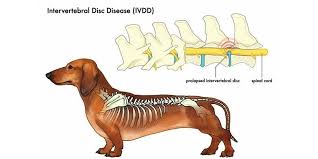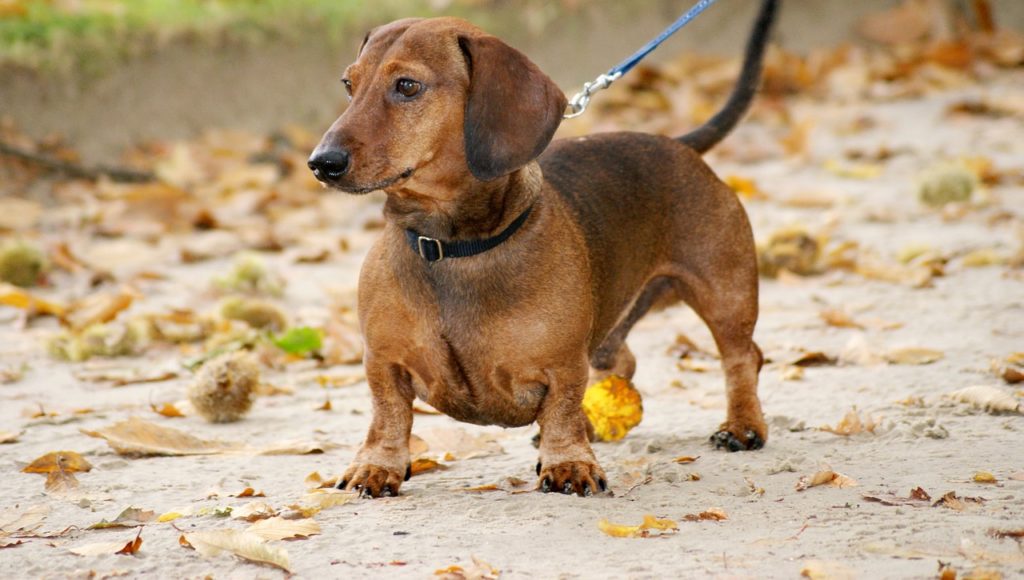Intervertebral disc disease (IVDD) is a degenerative condition of the spine in dogs. It is more common in chondrodystrophic dog breeds, with those breeds at a higher risk of suffering intervertebral disc problems when they’re young. The main reason for IVDD in dogs is the loss of the disc’s capacity to “hold water”. As a result, it becomes dehydrated.
IVDD in dogs has a range of symptoms, from relatively mild to very serious. On one end of the spectrum are mild pain, paralysis on the other end, and most dogs with the diagnosis fall somewhere in between.
Causes of IVDD
IVDD is a degenerative process that gradually affects the intervertebral discs in the spine. Unfortunately, a dog that looks perfectly healthy one day may fall or jump in such a way that the disc “slips” and becomes ruptured (herniated disc/prolapsed disc are describing the same issue). The fall or jump simply damaged a disc that was already weakened by IVDD.

IVDD is caused when the adjacent cushioning discs (which function as shock absorbers) between the spinal column’s vertebrae begin to harden (they lose water content). Eventually, they may stiffen to the point that they can no longer adequately cushion the spinal vertebrae. Consequently, a lousy landing or forceful jump can cause intervertebral discs to burst and press on the adjacent nerves that control the arms and/or legs. This can cause nerve damage with possible paralysis if the damage to the spinal cord is significant.
IVDD Symptoms:
Symptoms of IVDD can emerge suddenly or gradually over time, usually appearing between the ages of 3.5-6.5.
IVDD varies from one dog breed to another and depends on the severity of the IVDD. Some dog breeds are more prone to IVDD, but any dog breed can experience this disease. Early intervention is crucial to minimize the possibility of permanent nerve damage.
Here are some common symptoms of IVDD in dogs:
- Impaired gait
- Dragging rear leg(s)
- Increased sensitivity to movement or touch
- Paralysis
- Knuckling in feet
- Back/muscle spasms
- Lowered head when standing
- Obvious weakness or pain
- Stiffness of neck, limbs, or back
- Incontinence
Types of IVDD:
The symptoms you report in your dog, and the vet’s physical examination help localize the IVDD to a spinal region.
Cervical IVDD (neck):
The cervical IVDD dog usually has a history of painful behavior accompanied by barking or crying out without visible reason. Less frequently, they will have a pinched nerve which causes forelimb lameness in advanced stages. There will be severe pain in the neck when touched or moved, limb weakness, a tense neck, and impaired gait can be all present on the affected dog.
Spinal IVDD (mid and low back):
Dog’s with Spinal IVDD can present with sudden or progressive rear limb weakness. The severity of the symptoms varies from mild weakness to complete rear limb paralysis. The most commonly affected area is the thoracolumbar (where the mid-back joins the low-back) area followed by the lumbosacral area (where the low back joins the pelvis).
Which Dog Breeds Are Most Susceptible to IVDD?
Chondrodystrophic dog breeds are typically more susceptible to IVDD. This is due to a gene mutation (CDDY) causing abnormal premature degeneration of intervertebral discs (source). While short legs can also accompany IVDD, it is not always the case.
Susceptible chondrodystrophic dog breeds include:
- Dachshund
- Corgis
- Poodle
- Pekingese
- Cocker Spaniel
- Shih-Tzu

Non-chondrodystrophic dog breeds that are commonly affected by IVDD include:
- Labrador Retriever
- Doberman Pinscher
- German Shepherd
Diagnosis of IVDD:
A veterinary clinical examination will usually include X-rays and a neurological exam. While x-rays won’t view the spinal disc’s, they give clues as to the health of the spinal column. If there is vertebral narrowing, calcification, or lipping (spondylosis) there is a good chance that the intervertebral discs are also degenerative, with possible herniation.
Specialized imaging including CT scan, myelogram, MRI may also be required to confirm the diagnosis. These tests are used to locate the source of disc herniation/rupture.
Treatment of IVDD:
The nature of the treatment varies with IVDD symptoms. Oral anti-inflammatory drugs and cage rests are reserved for dogs with mild symptoms and often get better within 36-48 hours.
Suppose the diagnosis reveals mild to moderate injury. In that case, treatment may include administering anti-inflammatory medications and steroids to reduce pain and swelling, with confined rest required for five to six weeks. Rehabilitation will usually be required to build strength and endurance in the weakened muscles.
Cervical IVDD patients with even minor neurological dysfunction are considered surgical candidates.
Surgery and Myelography are indicated for all dogs that have failed to respond to oral/parenteral medication and have more severe or progressive symptoms.
Surgery for IVDD:
IVDD surgery involves making a small hole in the bone around the spinal cord to access the disc material. The internal material is removed, relieving the spinal cord and allowing it to heal.
If the dog has not lost the ability to stand or walk, and if the surgery is performed very soon after the diagnosis (within 24 hours), the surgery is more likely to be successful.
Surgery effectively relieves spinal compression, reduces pain, and maximizes the dog’s chances of recovery. If your dog is experiencing disc herniation, veterinary surgeons will work with your family veterinarian to determine the most effective care.
Physical rehabilitation after IVDD surgery to strengthen muscles is often recommended. If the surgery is not successful, a dog wheelchair usually gives the dog a healthy and active life despite the illness.
FAQ About IVDD in Dog’s
What is the success rate of IVDD surgeries in dogs?
The prognosis for patients with pain alone from cervical IVDD is excellent, with a >75% chance of eliminating pain and returning to an active lifestyle. The forecast for spinal IVDD patients depends on the presentation of the symptoms. Paralyzed or weak patients have the perfect opportunity to recover from surgery, with most dogs showing dramatic improvement in the first 3-4 weeks of the procedure. Dogs that are both paralyzed and unable to feel their legs have more severe spinal trauma and a more limited ability to heal. The prognosis of these dogs is discussed on a case-by-case basis.
What are the possible complications from IVDD surgery in dogs?
Overall complication rates are meager. Some dogs will experience “seizure-like” activity at once upon recovery from surgery. This is in response to the fluid injected during the myelogram. These reactions are not uncommon and are the response to the drug known as valium. All affected dogs are closely monitored for such responses. Any other potential complications related to your specific dog’s neurological status will be discussed during your visit to a veterinarian.
How long will your dog be hospitalized after IVDD surgery?
The length of your dog’s stay in hospital after IVDD surgery will be determined based on its postoperative comfort and neurological function. You will be frequently updated by hospital staff on your dog’s progress. The primary goal is to get your dog back home as soon as possible, without sacrificing post-surgical care.
What is post-surgery care look like?
Post-surgical care usually involves a four to six weeks activity restriction, which means no off-leash or independent activity. Additional consideration will be determined based on your dog’s neurological function. Some will need help urinating and walking, while others will need aggressive physical rehabilitation and medication. Your dog’s specific needs will be outlined during discharge from the hospital.
Do I need to bring my dog back for a checkup?
Yes. Assessing a dog’s progress recovering from spinal surgery is an essential part of an overall treatment plan. Most patients are re-examined in the hospital for four-six weeks after surgery, but a more frequent checkup may be recommended.
Will physical rehabilitation be necessary after spinal surgery?
Proper physical rehabilitation is essential in dog’s with neurological injuries/disorders. When your dog is discharged from the hospital, you may be given some exercises to perform with your dog. If your hospital has a rehabilitation department or if there is a local rehabilitation practitioner then it will be beneficial to seek their expertise during the rehabilitation phase of the recovery.
Prevention:
While there are genetic factors that play into IVDD, there are some practical things a pet owner can do to minimize the risk of IVDD:
- Minimize jumping on/off furniture
- Use a harness instead of the dog leash when walking with your dog. Harnesses put less pressure on the cervical vertebrae, reducing neck and shoulder stress.
- Keep your dog’s weight optimal by providing adequate exercises and training to reduce neck and back stress, especially for those breeds who are susceptible to IVDD.
Conculsion:
IVDD is characterized by degeneration of the intervertebral discs with possible herniation into the spinal cord. It primarily affects chondrodystrophic dog breeds but all dogs can be affected, especially those that are overweight.
IVDD can range from mild symptoms to significant neurological deficit. Surgery may be required in moderate to severe cases. IVDD recovery is a long process (4-6 weeks for basic recovery, months for a more serious case). So be patient and follow your veterinarian’s guidance to help your dog heal.
If you’d like more information on low back pain in agility dogs, click here.
